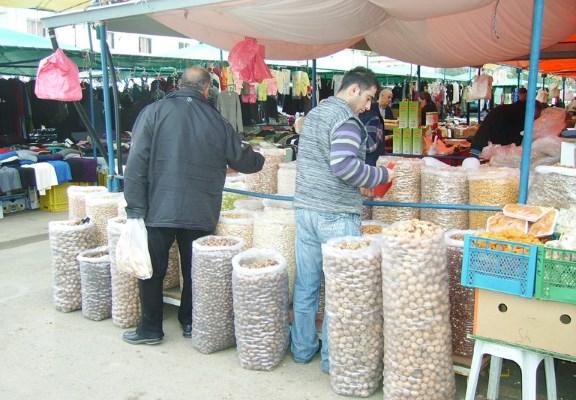North Cyprus Life – Market Days

North Cyprus Life – The British Residents Society
18 February, 2010
North Cyprus – Destination Kyrenia!
3 March, 2010All the major towns, Kyrenia, Famagusta, Iskele and Guzelyurt have their open markets on different days of the week. The big covered market in Nicosia is open every day except Sunday and sells the same variety of produce with a few added extras.
The markets of the TRNC are not like the large covered bazaars of Istanbul where the air is redolent with the scent of exotic spices and fragrant oils, nor is there the constant badgering by the stall holders to try/buy their produce. The markets here are far more like the ones of central Europe, where there is a market day in most towns with local fruit and vegetable growers selling their produce.

Market day – Artichokes
The open market in Kyrenia is held on Wednesday and it is always very busy come rain or shine. Time was when the only shelters were sheets of polythene that did a poor job of keeping out the rain of winter or the blistering heat of summer. Now all the major stalls have permanent stretched canvas covers and browsing among them is a pleasure.
The array of produce is mind boggling whatever the season, and the freshest and most succulent vegetables are the ones produced here in the TRNC. Carrots, cauliflower and broccoli all grown locally are among the best I have ever tasted. The carrots are sweet, firm and crunchy, almost better eaten raw than cooked. The white curds of the cauliflower are truly creamy and tightly packed, and the green of the broccoli is a deep, dark emerald. As a matter of historical note it is a part of Cyprus history that the first cauliflowers exported into mainland Europe were grown here in the valley that runs down through Degermenlik (Kythrea).
The market is never quiet as each stall holder calls out his wares, they vie with each other over prices, and who can shout the loudest, and sometimes it seems one is truly spoilt for choice. There is just so much colour and variety from the bright reds of the tomatoes and peppers, to the luscious greens of beans and courgettes, and the dark violet of the aubergines, with every shade of the spectrum in between.
There is an ironmongery stall selling garden implements, saucepans, knives etc. The nut stall, with tall sacks of walnuts, pecans, cashews, pistachio, some locally produced and some imported plus a selection of dried fruit – a cake makers delight. There are the clothes stalls, shoe stalls, linen stalls, and of course there are stalls that sell olive oil, (usually in old whisky or raki bottles,) eggs, cheeses etc. And sometimes you can even buy a fresh chicken! When I write fresh, I mean still clucking!

Market day – Nuts & Dried Fruit
As I sit at my desk, (after a trip to the market for the next few days vitamin intake, and photographs in season,) I can tell you that in full production now are the Globe artichokes, (Cynara scolymus). This artichoke, (not to be confused with the Jerusalem artichoke) is a member of the compositae family. It is a thistle with attitude! Very popular as part of the Cypriot menu it is eaten in a variety of ways. The heads may be boiled and the outer leaves stripped off individually, dipped in melted butter and the fleshy ends sucked off. The firm base of the flower head is called the heart and may be eaten raw or cooked. It resembles a small pastry tart case and thus can be stuffed with a savoury mince or rice. There are a still a few good Cypriot restaurants that will serve slices of artichoke that have been drizzled in olive oil and lemon juice then sprinkled with salt as part of the mezze.
Whichever town is nearest, whether you are resident or visitor, market day is an experience that should not be missed.





